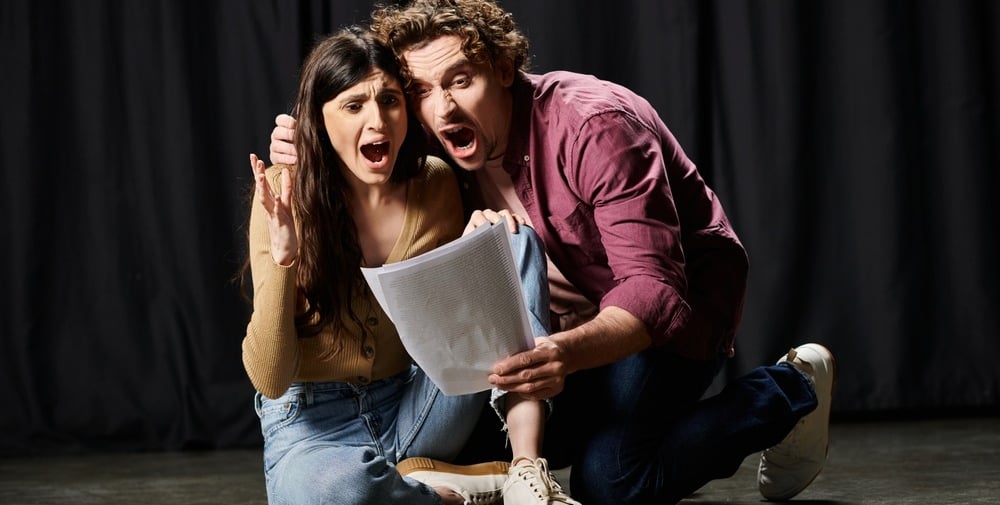Drama Class Scenes: How to Teach Scene Work for Actors
Looking for drama class scenes that build acting skills and collaboration? This guide to teaching scene work for actors covers scene partner projects, rehearsal tips, and free resources—perfect for your drama curriculum or acting class scenes.
Katie Zakkak
8/14/20253 min read


Scene Partner Project
Every semester I teach, I make sure to include at least one Scene Partner Project—where students select a scene (or are assigned one), rehearse with a partner, and work toward a final performance.
Why?
Because learning to work with a scene partner builds so much more than acting technique. It cultivates:
Trust
Collaboration
Active listening
And essential communication skills that students will carry with them for life
That’s why I created my Acting Scene Partner Unit, drawing from my experience as both a teacher and former theater student. It guides students step-by-step through scene work in a way that builds strong partnerships and compelling performances.
Why Scene Partner Work Matters
When students work in pairs on a scene, they have to do more than memorize lines and hit their marks. They must:
Listen in the moment
React truthfully
Understand both their own character and their partner’s
Work together to shape blocking, objectives, tone, and timing
That level of collaborative creativity teaches them to be generous, responsive actors—and better teammates in general.
How I Structure Scene Partner Work for Acting Class Scenes
🎭 Scene Selection
When possible, I let students choose their scene and partner. This gives them ownership and buy-in. But sometimes, for balance or scheduling, I assign either the partner or the script—and that works, too.
Free or low cost scene resources:
YouthPLAYS (Free Scenes for Teens)
Offers free two-person scenes from published plays aimed at teen actors (comedy, drama, dramedy)
To access, teachers or students fill out a Request a Scene form; permissions are typically responded to within 2 business days
Example scenes: “First Date?” (1 female, 1 male), “Miranda and Chuck”, “Cowboy and Cowgirl”, “We’re On a Mission”—all teen‑appropriate
Jonathan Dorf – Free Partner Scenes
Provides a collection of free two-person scenes that can be used for educational or audition purposes—just sign up for his email list to receive access
Scenes are written with teen voices in mind and usable with proper citation or in classroom settings.
Drama Notebook – Two‑Person Scenes for Teens
Offers original short scenes designed for older students (ages ~12–18), useful for rehearsal, script analysis, and performance practice
Designed to encourage natural dialogue exchange and connection between partners.
Claudia Haas – Free Classroom Scenes for Teens
Features many two‑person scenes drawn from published or festival-used plays, free for educational use only (not public performance without rights)
Includes scenes with varied themes and tones such as drama, fantasy, tragedy, or light-hearted comedy suitable for teen pairs.
Build Trust Before You Rehearse
Before we jump into blocking or memorizing, I always do:
Scene partner warm-ups to build connection and trust
Character connection games so students understand their roles and relationships
Discussions on objectives, tactics, and emotional journey
Being “in the moment” as an actor doesn’t just happen—it comes from preparation, trust, and presence. Warm-ups help unlock that.
Character & Objective Work
Each student must know their:
Character's backstory
Motivation and objective in the scene
Obstacles and tactics
And crucially: they must learn to listen to their partner and adjust in the moment. That’s what creates performances that feel real instead of robotic.
Practice, Feedback, and Performance
Before we get to the final scene performance, students:
Present a practice performance to get over nerves
Receive peer and teacher feedback
Rehearse again with that feedback in mind
From day one, I give students a rubric with clear expectations, so they know what they’re aiming for. That includes:
Character believability
Use of space/blocking
Vocal choices
Listening and reactivity
Final Thoughts
When students dive into scene partner work, they’re not just becoming better actors—they’re learning what it means to collaborate, trust, and grow together through the creative process.
If you're considering adding this kind of project to your curriculum, I highly recommend it. And if you’d like a ready-to-use resource to get you started, check out my Scene Partner Acting Unit.
Want more tips and freebies? Sign up for the email newsletter and receive the Drama Teacher Toolkit to get regular updates and classroom support delivered straight to your inbox.
Happy teaching—and break a leg!
